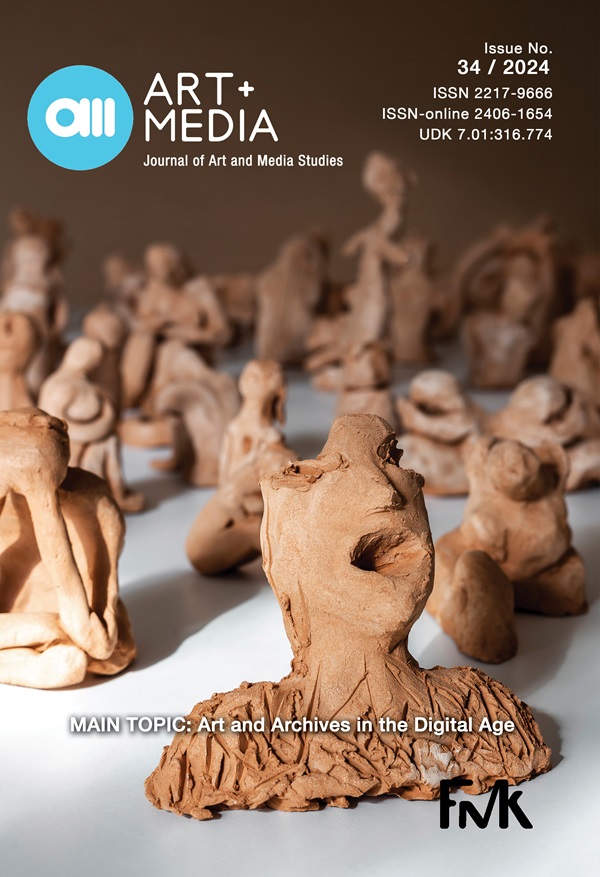Digital Mini-Archives: Social Media Users as Curators of an Architectural Utopia
DOI:
https://doi.org/10.25038/am.v0i28.562Keywords:
architecture archives; digital archives; social media; architectural utopia; Instagram; experimental design; experimental project.Abstract
This paper explores the importance and meaning of a new concept of architectural archives – digital mini-archives in the form of social media profiles (Instagram profiles), whether they are public or private. The paper's interpretation of digital architectural archives is based on Jacques Derrida's interpretation of archives. The aim is to analyze the relationship between archivists and users in the context of social media platforms, and the structure and content of digital mini-archives. I tried to select examples of different Instagram profiles whose content (photos, videos, and quotes) relates to architectural history and architectural design presented in an innovative manner. The hypothesis emphasizes a curating role of social media users as interpreters of architectural history references and their (new) meanings, as well as curators of the future of architecture. Also, the concept of architectural utopia concerns Nathaniel Coleman's theory of utopia in architecture and its contemporary interpretations. There is a strong bond between architectural utopia and digital mini-archives which enable architecture's utopian potential because of their flexibility, openness to change, and transformability. Thus, experimental projects with utopian potential are created based on digital mini-archives. However, do these digital mini-archives contribute by deciding which (part of) architectural history ought to be forgotten or remembered in collective memory and translated to another temporal context through experimental architectural design?
References
Christmann, Daniela (@vielfaltdermoderne). 2024. Instagram, April 24, 2024. https://www.instagram.com/vielfaltdermoderne/
Coleman, Nathaniel. “The Problematic of Architecture and Utopia.” Utopian Studies 25, 1 (2014): 1–22. DOI: https://doi.org/10.5325/utopianstudies.25.1.0001
Coleman, Nathaniel. “Utopia and Modern Architecture?” Architectural Research Quarterly 16, 4 (2012): 339–48. DOI: https://doi.org/10.1017/S1359135513000225
De Michelis, Marco, and Guido Zuliani, “Fundamentals.” Log 32 (Fall 2014): 93–102.
Enoch, Jessica, and Pamela VanHaitsma. “Archival Literacy: Reading the Rhetoric of Digital Archives in the Undergraduate Classroom.” College Composition and Communication 67, 2 (December 2015): 216–242. DOI: https://doi.org/10.58680/ccc201527643
Genex Tower – A Monument of an Era (@genex.tower). 2022. Instagram, April 23, 2022. https://www.instagram.com/genex.tower/
Jankov, Sonja. “Museum of the Revolution and Synthesis in Saša Tkačenko’s Eternal Flame.” Synaxa – Matica Srpska International Journal for Social Sciences, Arts and Culture 4–5 (1–2/2019): 77–87.
Lavin, Sylvia. “Today We Collect Everything.” Perspecta 48, AMNESIA (2015): 182–191.
Mladenović, Milorad (@milorad.mladenovic.71). 2024. “Milorad mladenović – plan za park ušće.” Instagram photo, April 1, 2018. https://www.instagram.com/p/BhBhlJan35t/
Moderni u Beogradu (@_mubgd). 2024. “Stefan Djordjević – Muzej revolucije.” Instagram photo, April 13, 2020. https://www.instagram.com/p/B-7IuGKpqg3/
Odlomci arhitekture | poezija prostora (@odlomci_arhitekture). 2024. Instagram, April 24, 2024. https://www.instagram.com/odlomci_arhitekture/
Picon, Antoine. “Learning From Utopia: Contemporary Architecture and the Quest for Political and Social Relevance.” Journal of Architectural Education 67, 1 (March 2013): 17–23. DOI: https://doi.org/10.1080/10464883.2013.767120
Ramiller, Alex and Patrick Schmidt. “Making Radical Change Real: Danish Sustainability, Adaptability, and the Reimagination of Architectural Utopias.” Utopian Studies 30, 2 (2019): 279–299. DOI: https://doi.org/10.5325/utopianstudies.30.2.0279
Richter Zbirka (@zbirka_richter). 2024. Instagram, April 24, 2024. https://www.instagram.com/zbirka_richter/
Roam, Matt. “You Are How You Collect.” Perspecta 48, AMNESIA (2015): 161–169. DOI: https://doi.org/10.1111/flan.12130
Schmetterling, Astrid. “Archival Obsessions: Arnold Dreyblatt's Memory Work.” Art Journal 66, 4 (Winter, 2007): 70–83. DOI: https://doi.org/10.1080/00043249.2007.10791284
Sladoljev, Igor. “14 – 14 Serbian Pavilion at 14th International Architecture Exhibition – La Biennale di Venezia.” Accessed April 22, 2024. http://igorsladoljev.com/projects/8
Tošić, Jovana. 2023. “Continuity or Discontinuity of Architectural History: Digital Repositories and Social Media as Archives in Architecture Archives of the Future.” In Proceedings of the Tenth Annual Conference of the Jaap Bakema Study Centre: Architecture Archives of the Future, Rotterdam, November 2023, 128–134. Rotterdam: TU Delft and Nieuwe Instituut.
Verbickas, Lukas (@objectsexuality). 2024. Instagram, April 24, 2024. https://www.instagram.com/objectsexuality/.
Weizman, Ines. “Architecture's Internal Exile: Experiments in Digital Documentation of Adolf Loos's Vienna Houses.” Architectural Design 88, 3 (2018): 32–39. DOI: https://doi.org/10.1002/ad.2298
Wigley, Mark. “Unleashing the Archive.” Future Anterior: Journal of Historic Preservation, History, Theory, and Criticism 2, 2 (Winter 2005): 10–15.
Zloković, Milan (@milanzlokovicfoundation). 2024. Instagram, April 24, 2024. https://www.instagram.com/milanzlokovicfoundation/
Zografos, Stamatis. “On Archives.” In Architecture and Fire: A Psychoanalytic Approach to Conservation. London: UCL Press, 2019. DOI: https://doi.org/10.2307/j.ctvb6v6jq
#SOCIALISTMODERNISM (@socialistmodernism). 2024. Instagram, April 24, 2024. https://www.instagram.com/socialistmodernism/
Downloads
Published
How to Cite
Issue
Section
License
Copyright (c) 2024 AM Journal of Art and Media Studies

This work is licensed under a Creative Commons Attribution 4.0 International License.
The content on this site is licensed under a Creative Commons Attribution 4.0 International License.
AM Journal of Art and Media Studies ISSN 2217-9666 - printed, ISSN 2406-1654 - online, UDK 7.01:316.774
Contact: amjournal@outlook.com
Publisher: Faculty of Media and Communications, Singidunum University, Belgrade, Serbia
Indexed in: ERIH PLUS, EBSCO, DOAJ, and in The List of Scientific Journals Categorization of Ministry of Education, Science and Technological Development of Republic of Serbia (M24 in 2021; M23 in 2023). Beginning with No. 12 2017, AM is indexed, abstracted and covered in Clarivate Analytics service ESCI.

